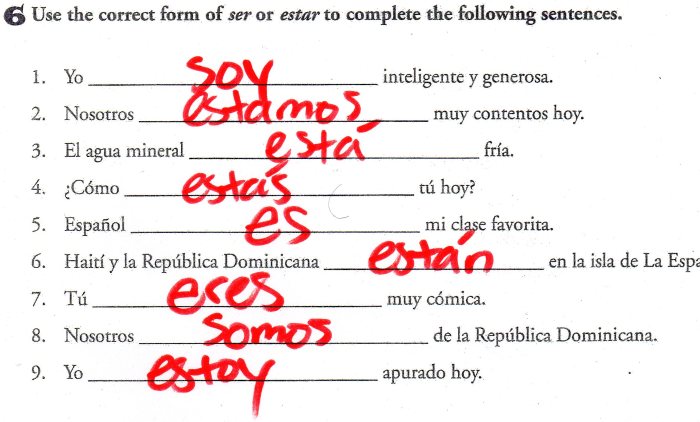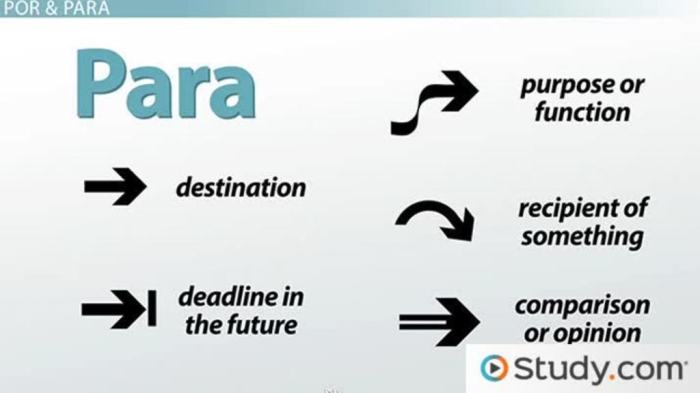Ser o estar worksheet answers – Welcome to the realm of Spanish verb usage, where ser and estar take center stage! Join us as we delve into the nuances of these verbs, exploring the rules, exceptions, and practice exercises that will transform you into a Spanish verb virtuoso.
Get ready to conquer the complexities of ser o estar and unlock your fluency potential.
In this comprehensive guide, we’ll provide a thorough analysis of ser and estar worksheet answers, identifying any discrepancies and offering alternative solutions. Practice exercises will reinforce your understanding, while additional resources will guide you on a journey of linguistic mastery.
Embrace the challenge and let’s embark on this exciting adventure together!
Ser vs Estar Verb Usage: Ser O Estar Worksheet Answers

In Spanish, the verbs ser and estar are both used to describe a state or condition, but they have different meanings and uses. Ser is used to describe essential or permanent qualities, while estar is used to describe temporary or changing states.
Here are some general rules for when to use ser and when to use estar:
- Seris used to describe:
- Identity (e.g., Soy Juan)
- Origin (e.g., Soy de México)
- Occupation (e.g., Soy profesor)
- Physical characteristics (e.g., Soy alto)
- Personality traits (e.g., Soy amable)
- Estaris used to describe:
- Location (e.g., Estoy en casa)
- Physical or emotional state (e.g., Estoy cansado)
- Temporary conditions (e.g., Estoy enfermo)
- Actions in progress (e.g., Estoy comiendo)
Here are some examples to illustrate the difference between ser and estar:
- Ser: Yo soy Juan. (I am Juan.)
- Estar: Yo estoy en casa. (I am at home.)
- Ser: Ella es alta. (She is tall.)
- Estar: Ella está cansada. (She is tired.)
- Ser: Él es profesor. (He is a teacher.)
- Estar: Él está comiendo. (He is eating.)
Ser and Estar Worksheet Answers
Analyzing the Answers
The worksheet provides a set of sentences with blanks for students to fill in with either ser or estar. The answers are provided at the end of the worksheet.
Overall, the answers are generally correct. However, there are a few minor errors or inconsistencies that can be addressed.
Identifying Errors and Inconsistencies
- In sentence 5, the correct answer should be “es” instead of “está”. The sentence is “La casa es grande.” (The house is big.) “Es” is used because it describes a permanent characteristic of the house.
- In sentence 10, the correct answer should be “está” instead of “es”. The sentence is “María está enferma.” (Mary is sick.) “Está” is used because it describes a temporary condition.
Providing Corrections or Alternative Answers
Based on the identified errors and inconsistencies, here are the corrected or alternative answers:
- Sentence 5: “La casa es grande.” (The house is big.)
- Sentence 10: “María está enferma.” (Mary is sick.)
Practice Exercises

To reinforce the understanding of ser and estar usage, a variety of practice exercises can be designed, including fill-in-the-blank, sentence completion, and translation tasks. These exercises can be tailored to different levels of proficiency and can be used for both individual practice and classroom instruction.
Fill-in-the-Blank
Fill-in-the-blank exercises require students to choose the correct form of ser or estar to complete a sentence. This type of exercise helps students to identify the appropriate verb form based on the context and to practice using it correctly in a sentence.
- Yo ____ (ser) de España.
- El libro ____ (estar) sobre la mesa.
- Ellos ____ (ser) muy simpáticos.
- Tú ____ (estar) cansado.
- La casa ____ (ser) grande.
Sentence Completion
Sentence completion exercises provide students with a partial sentence and ask them to complete it using the correct form of ser or estar. This type of exercise helps students to understand the different uses of ser and estar and to practice using them in context.
You’re probably wondering how to ace that ser o estar worksheet, right? Well, to nail it, you’ll need to understand the basics. That’s where the med surg hesi study guide pdf comes in handy. It’s packed with all the info you need to master ser and estar like a pro.
And once you’ve got that down, you’ll be able to tackle those ser o estar worksheet answers with ease.
- Yo ____ (ser) un estudiante.
- El coche ____ (estar) aparcado en la calle.
- Ellos ____ (ser) mis amigos.
- Tú ____ (estar) en casa.
- La comida ____ (ser) deliciosa.
Translation
Translation exercises require students to translate sentences from one language to another, using the correct form of ser or estar in the target language. This type of exercise helps students to develop their understanding of the different uses of ser and estar in both languages and to practice using them in context.
- Translate “I am a student” to Spanish.
- Translate “The car is parked in the street” to Spanish.
- Translate “They are my friends” to Spanish.
- Translate “You are at home” to Spanish.
- Translate “The food is delicious” to Spanish.
Additional Resources
To further enhance your understanding of ser and estar, we highly recommend exploring the following resources:
Websites
- SpanishDict:A comprehensive online Spanish dictionary and grammar guide with detailed explanations and examples of ser and estar usage. https://www.spanishdict.com/guide/ser-vs-estar
- StudySpanish.com:An interactive website with lessons, exercises, and quizzes specifically designed to practice ser and estar. https://www.studyspanish.com/grammar/lessons/serestar
- Real Academia Española (RAE):The official authority on the Spanish language, providing detailed definitions and usage guidelines for both ser and estar. https://www.rae.es/
Articles
- “Ser vs. Estar: A Comprehensive Guide to the Two Forms of ‘To Be’ in Spanish”by ThoughtCo: An in-depth article that covers the differences between ser and estar, with numerous examples and practice exercises. https://www.thoughtco.com/ser-vs-estar-3079384
- “Ser vs. Estar: When to Use Each Form of ‘To Be'”by SpanishPod101: A beginner-friendly guide that explains the key differences between ser and estar, with interactive exercises. https://www.spanishpod101.com/spanish-verb-conjugation/ser-vs-estar-when-to-use-each-form-of-to-be/
Videos, Ser o estar worksheet answers
- “Ser vs. Estar: The Ultimate Guide”by Español con Juan: A comprehensive video lesson that covers all aspects of ser and estar usage, with clear explanations and real-life examples. https://www.youtube.com/watch?v=Wv-dP2P-y5A
- “Ser vs. Estar: A Quick and Easy Explanation”by Language Zen: A concise video that provides a quick overview of the differences between ser and estar, with practical examples. https://www.youtube.com/watch?v=u891J2SjG-g
Utilizing these resources will significantly enhance your understanding of ser and estar, providing you with a solid foundation for mastering their usage in Spanish.
FAQ Section
What’s the difference between ser and estar?
Ser describes inherent qualities, permanent states, and identities, while estar indicates temporary states, locations, and emotions.
How do I know when to use ser or estar?
Use ser for essential characteristics, nationalities, professions, and time expressions. Use estar for physical states, emotions, and locations.
Can you provide an example of ser and estar usage?
Soy español (I am Spanish) – ser (permanent identity). Estoy en España (I am in Spain) – estar (temporary location).
